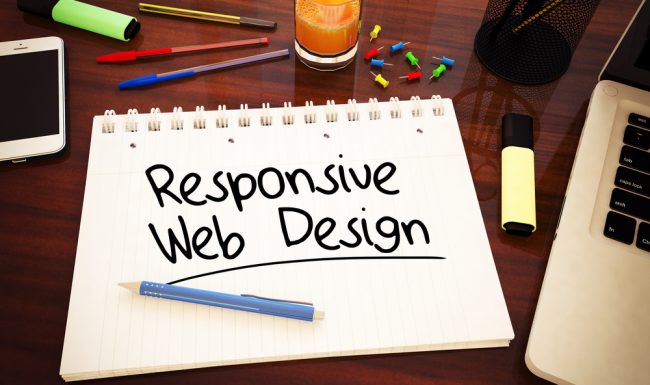With the word “mobile” flying around the web design world, it is easy to get confused about what is and what isn’t a true mobile website. As mobile website usage continues to increase exponentially, it’s important to respond to these consumer trends to effectively reach your on-the-go audience.
Differences Between a Mobile-Compatible and a Mobile-Friendly Website
You may have heard people refer to mobile websites as either “mobile-compatible” or “mobile-friendly.” While similar in wording, these terms represent significantly different outcomes. How your site appears to those using a mobile device can affect whether they become a new client or not. So, what is the difference?
- Mobile-compatible essentially means that your desktop website loads on mobile devices as a shrunken version of itself. These sites are often slow to load, difficult to navigate, and hard to read, quickly causing frustration among mobile users. According to a recent Google study, frustrated mobile users are 5 times more likely to leave your website and search for another site that meets their needs.
- Mobile-friendly websites are optimized for mobile devices and include thumb-friendly buttons, easy-to-read text, and super streamlined navigation.
What Does Mobile-Friendly Really Mean?
In basic terms, ‘mobile-friendly’ means a site can be as easily viewed on a small smartphone or tablet screen as it can on a traditional laptop or desktop screen.
In technical terms, your site needs to have three basic functions that make it easy to read across both large and small formats:
- It must avoid 3rd party software plug-ins that most mobile devices can’t handle, like Flash, Silverlight or Java.
- Its text and graphics must be viewable without needing to scroll or zoom.
- Links must be spaced far enough apart so they can easily be tapped.

Why Does It Matter if My Dental Site is Mobile-Friendly?
Search engines (Google, Yahoo, Bing, etc.) want people to be able to see and interact with your site on all types of devices. That’s because search engines know that if something is searched for, there’s a good chance the follow-up will be some kind of financial transaction. For local businesses (like a dental practice) a mobile search yields an in-person visit about 50% of the time. That’s really incredible! It makes sense if you think about it. Why else would you search for a business on your mobile phone unless you were enroute or already looking for it?
Are people searching for your practice for fun or out of boredom? Not likely. They’re searching for you to call you to schedule an appointment or to verify your address to visit in-person. So, these types of searches are valuable to Google because they’re valuable to you (and visa-versa).
Moreover, mobile devices aren’t just a small segment of internet use anymore…in early 2014, mobile internet traffic overtook desktop traffic. And that trend isn’t likely to reverse. More people are using mobile devices to interact online, and Google is taking steps to ensure mobile-friendly sites get better visibility.
In February, Google formally announced it would start giving preferential treatment to mobile-friendly sites starting April 21, 2015. You should care because mobile sites will get better rankings, more page views and ultimately, lower costs.
The Importance of a Mobile-Friendly Website for Your Practice
If your practice website isn’t mobile-friendly, you’re essentially hiding from prospective patients that use their smartphone to search for a dentist. As Google continues to prioritize the mobile experience for its searchers, not having a mobile-friendly site will undoubtedly hurt your rankings on search engine results pages.
Conversely, having a mobile-friendly website will help to boost your visibility on search results pages by delivering a better experience for your mobile visitors.
As mobile browser usage continues to skyrocket, having a mobile website is shifting from being a luxury to a necessity, and if you don’t have a mobile website, you’re letting potential patients slip away! Here are the 5 major reasons why you need a mobile website now:
- Like mobile phones, mobile websites are not a fad or trend – they’re here to stay. With the advent of Wi-Fi, Facebook, and numerous emerging technologies, nearly every new phone is equipped with Internet accessibility and a mobile browser, enabling cell phone users to have the Internet constantly at their fingertips. Over the past year, Google research shows the number of Internet users searching on a mobile device has quadrupled(!) – and that number continues to multiply.
- Mobile phones outnumber PCs 4:1. Here’s a little insight… your targeted audience is already searching for you via mobile browsers. 83% of the population has a mobile phone. If that statistic alone doesn’t astound you, how about this; 4.8 billion people have a mobile phone, while only 4.2 billion own a toothbrush! The mobile revolution is here, and if you aren’t marketing your practice accordingly, you may be missing out on new patients!
- Mobile users are even less patient than PC users. When searching, most mobile users are on-the-go, with 80% of searches inquiring about the nearest business or service. Because of this urgency, mobile users want their information fast. A mobile website has compressed images and less fluff, so download times are much faster than a mobile-compatible website. Faster page-load times = happier prospects.
- Google’s Smartphone Crawler is a search bot that crawls and ranks mobile sites differently than mobile-compatible websites within Google’s mobile search results. As more search engines debut new algorithms to account for mobile websites, a non-mobile or mobile-compatible website is sure to be left in the dust. Additionally, Google will naturally begin to rank mobile-friendly websites higher in the search results for mobile users in order to deliver a better search experience.
- Improve a mobile Internet user’s experience. Any good business puts their customers first and meets their demands. A mobile website is really an improvement in customer service, allowing clients and prospects to quickly access the information they desire. A mobile-compatible website will leave your clients squinting at the screen or will require them to constantly zoom in and out to find what they’re looking for. Mobile websites have thumb-friendly navigation and larger fonts for optimal viewing.

Mobile-Friendly Statistics That Matter
With more and more people turning to their mobile devices for information, it is essential to have a site that is compatible to their searches. A mobile-friendly website offers countless benefits to your practice.
- A recent Google study shows that 67% of mobile users are more likely to buy a product or use a service from businesses that have a mobile-friendly site.
- 74% of mobile users are more likely to return to a mobile-friendly website. More returning visitors = more repeat patients.
- We, as humans, are impatient. Mobile-friendly websites load in 5 seconds or less. This makes mobile visitors happy, as you have (indirectly) provided them with great customer service.
- Mobile websites encourage immediate action. With prominent “click-to-call” and “click-to-map” icons, patients can find and contact your practice – instantly.
- Users can easily navigate through your website with thumb-friendly buttons, reducing the need to zoom in and out and increasing the chance that they will find what they’re looking for.
- Enlarged text and resized images give users a seamless, optimal viewing experience on your mobile website.
How Do You Make Your Website Mobile-Friendly?
There are basically two ways to make your site mobile friendly. You can choose to make your current site mobile-friendly and responsive, or you can create a dedicated mobile website. Dedicated mobile sites are designed and laid out to fit mobile devices. It’s the same website address, but they “know” when they’re being viewed on a phone or tablet and are programmed to load the correct version.
Neither solution is necessarily better than the other, and all different kinds of businesses choose one fix over the other. For instance, almost every large retailer or consumer brand like Home Depot, Wal*Mart or Coca-Cola has a dedicated mobile site in addition to their regular desktop site. Blogs platforms and social media sites tend to be responsive. The important thing for Google is that sites are correctly displayed on mobile devices, so it’s something dental practices need to be on top of.
Mobile-friendly and/or responsive website must-haves
There are a handful of best practices that you must ensure your mobile-friendly site contains:
- Quick load times: According to Google, 53% of users will abandon a site if it doesn’t load within three seconds.
- Easy Navigation: On a mobile site it’s best to keep things simple. Have a menu that is easy to navigate and doesn’t require multiple taps to get to the desired page. Avoid multi-level menus, and instead aim to have a hamburger menu (where options expand from the side).
- Designed for Touch: Make sure that your buttons are thumb-friendly and easily accessible, so visitors aren’t forced to zoom in.
- Text and Images: Mobile-friendly websites should have resized images and text to provide an optimal viewing experience. Users are unlikely to take the time to zoom in and out of your content, and rather hit the “back” button.
- Keep Forms Minimal: The golden rule of thumb is the longer the form, the less people will fill it out. If you have new patient appointment requests, make sure to ask for only the absolutely necessary information upfront.

A Mobile-Friendly Website Will Benefit Your Practice
If you are unsure about the current mobile-friendly status of your current website, you can Click Our Tool Here to see how your website appears on a smartphone or tablet by entering your website address at the top of the page.
If you results leave a lot to be desired when it comes to site navigation, keep in mind that 1 in 3 searches conducted from a mobile device is for a local business or service, and that number increases every day.
Get a head-start on your competition and get a mobile website. To find out more about reaching on-the-go patients with a mobile website for your practice, contact us at (888) 932-3644.








